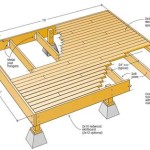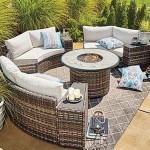Outdoor Under Deck Patio Ideas: A DIY Guide
Creating an outdoor patio space beneath an existing deck offers a unique opportunity to expand living areas and enhance the usability of outdoor spaces. This area, often underutilized, can be transformed into a functional and aesthetically pleasing retreat. The following guide provides a comprehensive overview of DIY under-deck patio ideas, covering planning, materials, construction techniques, and design considerations.
Planning and Preparation
Before embarking on any construction project, meticulous planning is crucial. The initial step involves a thorough assessment of the existing deck structure and the underlying ground conditions. Determine the dimensions of the under-deck area to ascertain the available square footage for the patio. Consider the height clearance beneath the deck, ensuring adequate vertical space for comfortable movement and furniture placement. Measure the distance from the bottom of the deck joists to the ground to determine the maximum allowable thickness of the patio surface. This measurement will dictate the material choices and construction methods that can be employed.
Examine the drainage characteristics of the soil. Poor drainage can lead to water accumulation, creating a damp and potentially unusable space. Evaluate the slope of the ground and identify any areas where water tends to pool. If drainage is an issue, consider installing a drainage system to divert water away from the patio area. Options include French drains, surface drains, or grading the soil to create a gentle slope away from the deck foundation.
Develop a detailed design plan that outlines the layout of the patio, the materials to be used, and any additional features, such as lighting, seating, or landscaping. The design should align with the homeowner's aesthetic preferences and functional requirements. Consider the intended use of the patio space. Will it be used for dining, lounging, entertaining, or a combination of these activities? The intended use will influence the selection of furniture, accessories, and overall design elements.
Create a budget that accounts for all materials, tools, and labor costs. Research the prices of various materials and obtain quotes from local suppliers. Factor in the cost of any required permits. Adhering to local building codes is essential to ensure the safety and legality of the project. Contact the local building department to inquire about any necessary permits or inspections. Obtain all required permits before commencing any construction activities.
Material Selection and Installation
The choice of materials for an under-deck patio significantly impacts its appearance, durability, and maintenance requirements. Several materials are suitable for this application, each with its own set of advantages and disadvantages.
Gravel:
Gravel is a cost-effective and relatively easy-to-install option. It provides excellent drainage and is available in a variety of colors and sizes. To install a gravel patio, excavate the area to a depth of several inches. Compact the soil and install a layer of landscape fabric to prevent weeds from growing through the gravel. Spread the gravel evenly over the fabric and compact it with a plate compactor. Considerations include the potential for gravel displacement and the need for periodic replenishment.Pavers:
Pavers offer a more refined and durable patio surface. They are available in a wide range of colors, shapes, and sizes, allowing for creative design possibilities. Pavers can be made from concrete, brick, or natural stone. Installation involves excavating the area, compacting the soil, and installing a base layer of gravel. A layer of sand is then spread over the gravel to provide a level surface for the pavers. The pavers are laid in the desired pattern and compacted with a plate compactor. The joints between the pavers are filled with sand or polymeric sand. Pavers require minimal maintenance and can withstand heavy use.Concrete:
Concrete provides a smooth, durable, and low-maintenance patio surface. It can be poured in place or pre-cast into slabs. Pouring concrete requires careful preparation, including the construction of forms and the reinforcement of the concrete with rebar. Concrete can be colored, stamped, or textured to enhance its aesthetic appeal. Pre-cast concrete slabs are easier to install but may be more expensive than poured concrete. Concrete is susceptible to cracking, so it is important to install it properly and provide adequate expansion joints.Composite Decking:
Composite decking materials offer a durable and weather-resistant alternative to traditional wood. These materials are made from a blend of wood fibers and plastic, offering the aesthetic appeal of wood without the maintenance requirements. Composite decking can be installed directly over a gravel or concrete base. Consider incorporating drainage systems beneath the decking to manage water runoff. While offering a more finished look, composite decking can be more expensive than gravel or pavers.The installation process for each material requires specific tools and techniques. Ensure that all tools are readily available and that the installer is familiar with the proper procedures. Properly installed patios will provide years of enjoyment and enhance the value of the property.
Addressing Under-Deck Moisture Management
One of the primary concerns when creating an under-deck patio is managing moisture. Rainwater and melting snow can drip through the deck boards, creating a damp and uncomfortable environment. Several solutions can address this issue and create a dry and usable space.
Under-Deck Drainage Systems:
These systems are designed to capture and divert water that drips through the deck boards. They typically consist of a series of troughs or panels that are installed beneath the deck joists. The panels are angled to direct water towards a gutter system, which then channels the water away from the patio area. Under-deck drainage systems are effective at keeping the patio dry but can be relatively expensive to install. Careful planning and installation are essential to ensure proper drainage and prevent leaks.Roofing Materials:
Installing a solid roof beneath the deck can provide complete protection from rain and snow. Roofing materials such as corrugated metal or polycarbonate panels can be attached to the deck joists to create a watertight barrier. A slight slope should be incorporated into the roof to facilitate water runoff. Roofing materials offer excellent protection from the elements but can significantly reduce the amount of natural light that reaches the patio area.Waterproof Membranes:
Waterproof membranes can be applied to the underside of the deck boards to create a waterproof barrier. These membranes are typically made from rubber or plastic and are installed using adhesives or fasteners. Waterproof membranes are less intrusive than under-deck drainage systems or roofing materials but may not be as effective at diverting large amounts of water. Proper surface preparation is essential to ensure that the membrane adheres properly and provides a watertight seal.Proper ventilation is crucial to prevent moisture buildup and mold growth. Ensure that the patio area is adequately ventilated to allow air to circulate and dry out any moisture. Consider installing ventilation fans or leaving gaps between the patio surface and the deck structure to promote airflow.
Enhancing the Under-Deck Patio Space
Beyond addressing drainage, several design elements can transform the under-deck area into a welcoming and functional outdoor living space. These elements include lighting, seating, landscaping, and decorative features.
Lighting:
Adequate lighting is essential for creating a safe and inviting patio area, especially during evening hours. Several lighting options are available, including string lights, recessed lighting, and landscape lighting. String lights can be strung between the deck joists to create a festive and ambient atmosphere. Recessed lighting can be installed in the deck overhang to provide focused illumination. Landscape lighting can be used to highlight plants and architectural features. Consider using low-voltage LED lighting to conserve energy and reduce operating costs. Ensure that all electrical wiring is installed in accordance with local building codes and that all fixtures are weatherproof.Seating:
The choice of seating depends on the intended use of the patio and the available space. Options include lounge chairs, dining tables, benches, and outdoor sofas. Select furniture that is weather-resistant and comfortable. Consider adding cushions and pillows to enhance comfort and add a splash of color. Arrange the seating to encourage conversation and create a comfortable and inviting atmosphere.Landscaping:
Incorporating plants and greenery can soften the hardscape and create a more natural and relaxing environment. Consider planting shade-tolerant plants that thrive in low-light conditions. Options include ferns, hostas, and impatiens. Vertical gardens can be installed on the deck supports to add visual interest and maximize space. Potted plants can be used to add color and texture. Ensure that all plants are properly watered and fertilized.Decorative Features:
Decorative features can add personality and charm to the patio area. Consider adding a water feature, such as a fountain or pond, to create a soothing and relaxing atmosphere. Outdoor rugs can define seating areas and add warmth and texture. Artwork and sculptures can be used to add visual interest. Consider painting the deck supports to match the color of the house or the patio surface. Small details can make a big difference in the overall look and feel of the patio area.By carefully considering these design elements, homeowners can transform an underutilized space into a beautiful and functional outdoor retreat.
DIY Considerations and Safety
Undertaking an under-deck patio project as a DIY endeavor requires careful consideration of skill level, time commitment, and safety precautions. While offering potential cost savings, DIY projects demand a thorough understanding of construction techniques and adherence to safety guidelines.
Assess personal skills and experience before embarking on the project. If unfamiliar with carpentry, concrete work, or electrical wiring, consider enlisting the help of experienced friends or hiring professionals for specific tasks. A lack of expertise can lead to costly mistakes and potential safety hazards.
Allocate sufficient time for the project. DIY projects often take longer than anticipated, so plan accordingly. Break the project down into smaller, manageable tasks and set realistic deadlines. Allow for unexpected delays due to weather or material shortages.
Prioritize safety by wearing appropriate personal protective equipment (PPE), including safety glasses, gloves, and a dust mask. Use power tools with caution and follow the manufacturer's instructions. Ensure that all electrical wiring is properly grounded and that all circuits are protected by ground fault circuit interrupters (GFCIs). Be aware of potential hazards, such as falling objects, sharp edges, and unstable surfaces. Never work alone, and always have someone nearby in case of an emergency.
Familiarize oneself with local building codes and regulations before starting the project. Contact the local building department to inquire about any necessary permits or inspections. Failure to comply with building codes can result in fines or the need to redo the work. Adhering to safety guidelines and regulations is essential to ensure the safety and legality of the project.
A successfully executed DIY under-deck patio can significantly enhance the homeowner’s enjoyment of their outdoor space, provided the project is approached with proper planning, skill, and a commitment to safety.

Landscaping Under A Deck Our 3 Options After The Build

14 Backyard Deck Ideas To Upgrade Your Outdoor Space

25 Best Under Deck Patio Ideas Inspirations For You

25 Best Under Deck Patio Ideas Inspirations For You

Diy Budget Porch Decor Outdoor Patio Decorate With Me Deck Ideas Adaline Zook

25 Best Patio Cover Ideas Covered Designs

15 Gorgeous Deck And Patio Ideas You Can Diy Family Handyman

21 Small Deck Ideas To Elevate Your Outdoor Space Timbertech

Swag Chainlink Bower Power

26 Best Patio Decorating Ideas Decor On A Budget
See Also








